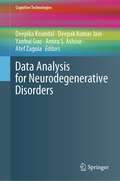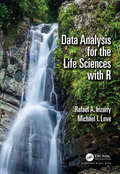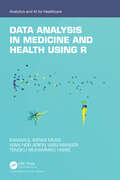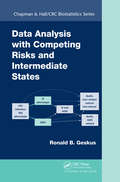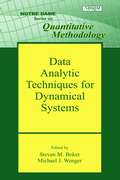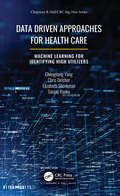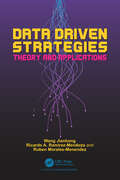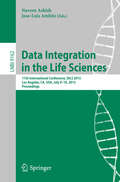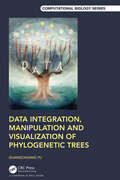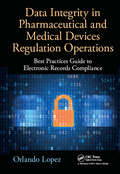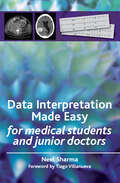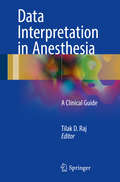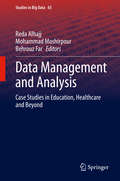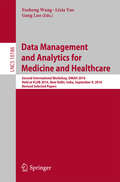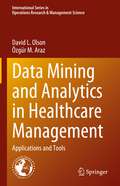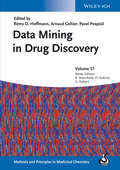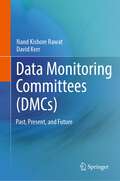- Table View
- List View
Das schöpferische Gehirn: Auf der Suche nach der Kreativität – eine Fahndung in sieben Tagen
by Konrad LehmannDas Geheimnis des Geistesblitzes – entschlüsselt Dieses Buch ist eine Einladung zu einer aufregenden Spurensuche: Erkunden Sie Schritt für Schritt die neuronalen Grundlagen der menschlichen Kreativität. Sie werden dabei unweigerlich einige Überraschungen erleben. Die Kulturgeschichte des Menschen ist nicht zuletzt die Geschichte großer Gedanken und genialer Neuerungen – und damit die Geschichte geistsprühender Gehirne. Seit wenigen Jahren erst ergründen die Neurowissenschaften, was in solchen Gehirnen vorgeht, wenn sie neue Ideen hervorbringen und verwirklichen. Der erfahrene Hirnforscher Konrad Lehmann gewährt uns einen ebenso unterhaltsamen wie informativen Einblick in diese fesselnde Forschungsrichtung: Was ist eine kreative Persönlichkeit? Sind Genies wirklich verrückt? Woher kommt der Antrieb, kreativ zu sein? Welche Gehirngebiete sind aktiv, wenn wir rappen oder jazzen? Und welche, wenn wir eine zündende Idee haben? Warum kommen die besten Einfälle im Schlaf? Die Suche nach der Kreativität im Gehirn ist spannend wie ein Krimi. Begleiten Sie den Autor und Commissario Prefrontale auf einer doppelten Fahndung: in den Gassen einer sich verändernden Stadt und durch die dunklen Windungen des Gehirns.___"Das schöpferische Gehirn" ist die erste deutschsprachige Einführung in die neurobiologische Kreativitätsforschung, die sich an ein allgemeines Publikum richtet. Das Buch vereint wissenschaftliche Sorgfalt, kulturelle Bildung und stilistisches Feuer. Komplexe Zusammenhänge werden unterhaltsam und bildhaft vermittelt, wozu die allegorische Rahmenhandlung beiträgt.
Data Analysis for Neurodegenerative Disorders (Cognitive Technologies)
by Amira S. Ashour Yanhui Guo Deepika Koundal Deepak Kumar Jain Atef ZaguiaThis book explores the challenges involved in handling medical big data in the diagnosis of neurological disorders. It discusses how to optimally reduce the number of neuropsychological tests during the classification of these disorders by using feature selection methods based on the diagnostic information of enrolled subjects. The book includes key definitions/models and covers their applications in different types of signal/image processing for neurological disorder data. An extensive discussion on the possibility of enhancing the abilities of AI systems using the different data analysis is included. The book recollects several applicable basic preliminaries of the different AI networks and models, while also highlighting basic processes in image processing for various neurological disorders. It also reports on several applications to image processing and explores numerous topics concerning the role of big data analysis in addressing signal and image processing in various real-world scenarios involving neurological disorders.This cutting-edge book highlights the analysis of medical data, together with novel procedures and challenges for handling neurological signals and images. It will help engineers, researchers and software developers to understand the concepts and different models of AI and data analysis. To help readers gain a comprehensive grasp of the subject, it focuses on three key features:● Presents outstanding concepts and models for using AI in clinical applications involving neurological disorders, with clear descriptions of image representation, feature extraction and selection.● Highlights a range of techniques for evaluating the performance of proposed CAD systems for the diagnosis of neurological disorders.● Examines various signal and image processing methods for efficient decision support systems. Soft computing, machine learning and optimization algorithms are also included to improve the CAD systems used.
Data Analysis for the Life Sciences with R
by Rafael A. Irizarry Michael I. LoveThis book covers several of the statistical concepts and data analytic skills needed to succeed in data-driven life science research. The authors proceed from relatively basic concepts related to computed p-values to advanced topics related to analyzing highthroughput data. They include the R code that performs this analysis and connect the lines of code to the statistical and mathematical concepts explained.
Data Analysis in Medicine and Health using R (Analytics and AI for Healthcare)
by Kamarul Imran Musa Wan Nor Mansor Tengku Muhammad HanisIn medicine and health, data are analyzed to guide treatment plans, patient care and control and prevention policies. However, in doing so, researchers in medicine and health often lack the understanding of data and statistical concepts and the skills in programming. In addition, there is also an increasing demand for data analyses to be reproducible, along with more complex data that require cutting-edge analysis. This book provides readers with both the fundamental concepts of data and statistical analysis and modeling. It also has the skills to perform the analysis using the R programming language, which is the lingua franca for statisticians. The topics in the book are presented in a sequence to minimize the time to help readers understand the objectives of data and statistical analysis, learn the concepts of statistical modeling and acquire the skills to perform the analysis. The R codes and datasets used in the book will be made available on GitHub for easy access. The book will also be live on the website bookdown.org, a service provided by RStudio, PBC, to host books written using the bookdown package in the R programming language.
Data Analysis in Sport: Analysis, Visualisation And Decision-making In Sports Performance (Routledge Studies in Sports Performance Analysis)
by Peter O'Donoghue Lucy HolmesMaking sense of sports performance data can be a challenging task but is nevertheless an essential part of performance analysis investigations. Focusing on techniques used in the analysis of sport performance, this book introduces the fundamental principles of data analysis, explores the most important tools used in data analysis, and offers guidance on the presentation of results. The book covers key topics such as: The purpose of data analysis, from statistical analysis to algorithmic processing Commercial packages for performance and data analysis, including Focus, Sportscode, Dartfish, Prozone, Excel, SPSS and Matlab Effective use of statistical procedures in sport performance analysis Analysing data from manual notation systems, player tracking systems and computerized match analysis systems Creating visually appealing ‘dashboard’ interfaces for presenting data Assessing reliability. The book includes worked examples from real sport, offering clear guidance to the reader and bringing the subject to life. This book is invaluable reading for any student, researcher or analyst working in sport performance or undertaking a sport-related research project or methods course
Data Analysis of Medical Studies: Reading and Reporting
by Potter C. ChangThis book is written for the many health professionals who are regularly frustrated by elegant but ambiguous descriptions of results of data analysis. It uses articles of the New England Journal of Medicine to demonstrate how ambiguous descriptions of results of data analysis may be read, so that it is clear what they do and do not reveal. These demonstrations also show how statistics is misused.
Data Analysis with Competing Risks and Intermediate States (Chapman & Hall/CRC Biostatistics Series)
by Ronald B. GeskusThis practical and thorough book explains when and how to use models and techniques for the analysis of competing risks and intermediate states. It covers the most recent insights on estimation techniques and discusses in detail how to interpret the obtained results. Each chapter includes standard exercises; a software section on SAS, Stata, and R; and computer practicals that allow readers to practice with the techniques. The book's website provides the R code for the computer practicals along with other material.
Data Analytic Techniques for Dynamical Systems (Notre Dame Series On Quantitative Methodology Ser.)
by Steven M. Boker Michael J. WengerEach volume in the Notre Dame Series on Quantitative Methodology features leading methodologists and substantive experts who provide instruction on innovative techniques designed to enhance quantitative skills in a substantive area. This latest volume focuses on the methodological issues and analyses pertinent to understanding psychological data from a dynamical system perspective. Dynamical systems analysis (DSA) is increasingly used to demonstrate time-dependent variable change. It is used more and more to analyze a variety of psychological phenomena such as relationships, development and aging, emotional regulation, and perceptual processes. The book opens with the best occasions for using DSA methods. The final two chapters focus on the application of dynamical systems methods to problems in psychology such as substance use and gestural dynamics. In addition, it reviews how and when to use: time series models from a discrete time perspective stochastic differential equations in continuous time estimating continuous time differential equation models multilevel models of differential equations to estimate within-person dynamics and the corresponding population means new SEM models for dynamical systems data Data Analytic Techniques for Dynamical Systems is beneficial to advanced students and researchers in the areas of developmental psychology, family studies, language processes, cognitive neuroscience, social and personality psychology, medicine, and emotion. Due to the book’s instructive nature, it serves as an excellent text for advanced courses on this particular technique.
Data Analytics for Traditional Chinese Medicine Research
by Josiah Poon Simon K. PoonThis contributed volume explores how data mining, machine learning, and similar statistical techniques can analyze the types of problems arising from Traditional Chinese Medicine (TCM) research. The book focuses on the study of clinical data and the analysis of herbal data. Challenges addressed include diagnosis, prescription analysis, ingredient discoveries, network based mechanism deciphering, pattern-activity relationships, and medical informatics. Each author demonstrates how they made use of machine learning, data mining, statistics and other analytic techniques to resolve their research challenges, how successful if these techniques were applied, any insight noted and how these insights define the most appropriate future work to be carried out. Readers are given an opportunity to understand the complexity of diagnosis and treatment decision, the difficulty of modeling of efficacy in terms of herbs, the identification of constituent compounds in an herb, the relationship between these compounds and biological outcome so that evidence-based predictions can be made. Drawing on a wide range of experienced contributors, Data Analytics for Traditional Chinese Medicine Research is a valuable reference for professionals and researchers working in health informatics and data mining. The techniques are also useful for biostatisticians and health practitioners interested in traditional medicine and data analytics.
Data Driven Approaches for Healthcare: Machine learning for Identifying High Utilizers (Chapman & Hall/CRC Big Data Series)
by Sanjay Ranka Chengliang Yang Chris Delcher Elizabeth ShenkmanHealth care utilization routinely generates vast amounts of data from sources ranging from electronic medical records, insurance claims, vital signs, and patient-reported outcomes. Predicting health outcomes using data modeling approaches is an emerging field that can reveal important insights into disproportionate spending patterns. This book presents data driven methods, especially machine learning, for understanding and approaching the high utilizers problem, using the example of a large public insurance program. It describes important goals for data driven approaches from different aspects of the high utilizer problem, and identifies challenges uniquely posed by this problem. Key Features: Introduces basic elements of health care data, especially for administrative claims data, including disease code, procedure codes, and drug codes Provides tailored supervised and unsupervised machine learning approaches for understanding and predicting the high utilizers Presents descriptive data driven methods for the high utilizer population Identifies a best-fitting linear and tree-based regression model to account for patients’ acute and chronic condition loads and demographic characteristics
Data Driven Approaches on Medical Imaging
by Bin Zheng Stefan Andrei Md Kamruzzaman Sarker Kishor Datta GuptaThis book deals with the recent advancements in computer vision techniques such as active learning, few-shot learning, zero shot learning, explainable and interpretable ML, online learning, AutoML etc. and their applications in medical domain. Moreover, the key challenges which affect the design, development, and performance of medical imaging systems are addressed. In addition, the state-of-the-art medical imaging methodologies for efficient, interpretable, explainable, and practical implementation of computer imaging techniques are discussed. At present, there are no textbook resources that address the medical imaging technologies. There are ongoing and novel research outcomes which would be useful for the development of novel medical imaging technologies/processes/equipment which can improve the current state of the art.The book particularly focuses on the use of data driven new technologies on medical imaging vision such as Active learning, Online learning, few shot learning, AutoML, segmentation etc.
Data Driven Science for Clinically Actionable Knowledge in Diseases (Analytics and AI for Healthcare)
by Quang Vinh Nguyen Simeon J. Simoff Daniel R. Catchpoole Paul J. KennedyData-driven science has become a major decision-making aid for the diagnosis and treatment of disease. Computational and visual analytics enables effective exploration and sense making of large and complex data through the deployment of appropriate data science methods, meaningful visualisation and human-information interaction. This edited volume covers state-of-the-art theory, method, models, design, evaluation and applications in computational and visual analytics in desktop, mobile and immersive environments for analysing biomedical and health data. The book is focused on data-driven integral analysis, including computational methods and visual analytics practices and solutions for discovering actionable knowledge in support of clinical actions in real environments. By studying how data and visual analytics have been implemented into the healthcare domain, the book demonstrates how analytics influences the domain through improving decision making, specifying diagnostics, selecting the best treatments and generating clinical certainty.
Data Driven Strategies: Theory and Applications
by Ricardo A. Ramirez-Mendoza Ruben Morales-Menendez Wang JianhongA key challenge in science and engineering is to provide a quantitative description of the systems under investigation, leveraging the noisy data collected. Such a description may be a complete mathematical model or a mechanism to return controllers corresponding to new, unseen inputs. Recent advances in the theories are described in detail, along with their applications in engineering. The book aims to develop model-free system analysis and control strategies, i.e., data-driven control from theoretical analysis and engineering applications based only on measured data. The study aims to develop system identification, and combination in advanced control theory, i.e., data-driven control strategy as system and controller are generated from measured data directly. The book reviews the development of system identification and its combination in advanced control theory, i.e., data-driven control strategy, as they all depend on measured data. Firstly, data-driven identification is developed for the closed-loop, nonlinear system and model validation, i.e., obtaining model descriptions from measured data. Secondly, the data-driven idea is combined with some control strategies to be considered data-driven control strategies, such as data-driven model predictive control, data-driven iterative tuning control, and data-driven subspace predictive control. Thirdly data-driven identification and data-driven control strategies are applied to interested engineering. In this context, the book provides algorithms to perform state estimation of dynamical systems from noisy data and some convex optimization algorithms through identification and control problems.
Data Integration in the Life Sciences: 11th International Conference, DILS 2015, Los Angeles, CA, USA, July 9-10, 2015, Proceedings (Lecture Notes in Computer Science #9162)
by Naveen Ashish Jose-Luis AmbiteThis book constitutes the proceedings of the 11th International Conference on Data Integration in the Life Sciences, DILS 2015, held in Los Angeles, CA, USA, in July 2015. The 24 papers presented in this volume were carefully reviewed and selected from 40 submissions. They are organized in topical sections named: data integration technologies; ontology and knowledge engineering for data integration; biomedical data standards and coding; medical research applications; and graduate student consortium.
Data Integration, Manipulation and Visualization of Phylogenetic Trees (Chapman & Hall/CRC Computational Biology Series)
by Guangchuang YuData Integration, Manipulation and Visualization of Phylogenetic Trees introduces and demonstrates data integration, manipulation and visualization of phylogenetic trees using a suite of R packages, tidytree, treeio, ggtree and ggtreeExtra. Using the most comprehensive packages for phylogenetic data integration and visualization, contains numerous examples that can be used for teaching and learning. Ideal for undergraduate readers and researchers with a working knowledge of R and ggplot2. Key Features: Manipulating phylogenetic tree with associated data using tidy verbs Integrating phylogenetic data from diverse sources Visualizing phylogenetic data using grammar of graphics
Data Integrity in Pharmaceutical and Medical Devices Regulation Operations: Best Practices Guide to Electronic Records Compliance
by Orlando LopezData integrity is fundamental in a pharmaceutical and medical devices quality system. This book provides practical information to enable compliance with data integrity, while highlighting and efficiently integrating worldwide regulation into the subject. The ideas presented in this book are based on many years’ experience in regulated industries in various computer systems development, maintenance, and quality functions. In addition to case studies, a practical approach will be presented to increase efficiency and to ensure that the design and testing of the data integrity controls are correctly achieved.
Data Intelligence and Cognitive Informatics: Proceedings of ICDICI 2021 (Algorithms for Intelligent Systems)
by Robert Bestak I. Jeena Jacob Selvanayaki Kolandapalayam ShanmugamThe book is a collection of peer-reviewed best selected research papers presented at the International Conference on Data Intelligence and Cognitive Informatics (ICDICI 2021), organized by SCAD College of Engineering and Technology, Tirunelveli, India, during July 16–17, 2021. This book discusses new cognitive informatics tools, algorithms, and methods that mimic the mechanisms of the human brain which leads to an impending revolution in understating a large amount of data generated by various smart applications. The book includes novel work in data intelligence domain which combines with the increasing efforts of artificial intelligence, machine learning, deep learning, and cognitive science to study and develop a deeper understanding of the information processing systems.
Data Interpretation Made Easy: For Medical Students and Junior Doctors
by Neel SharmaThe ability to interpret and synthesise medical data is essential for doctors, yet it is a skill which can be difficult to master. Data Interpretation Made Easy focuses on developing this skill by presenting an array of case-based themes considering interpretation of blood results, X-rays, ECGs and CT images in medicine with discussion of evidence-based practice. The concise, list-based text aids easy comprehension and images provide the much needed link from raw data to evidence-based care and management. This highly practical book is essential reading for undergraduate medical students preparing for examinations. It is also ideal for junior doctors needing a succinct guide to data interpretation for everyday use. 'Dr Neel Sharma's latest venture on data interpretation has dozens of credible clinical scenarios covering many key areas of clinical medicine. And you will certainly feel challenged, as he leaves it up to you to diagnose and devise the treatment plan.' From the Foreword by Tiago Villanueva
Data Interpretation in Anesthesia
by Tilak D. RajFocusing on the interpretation of data commonly available to anesthesiologists, this book presents a data point, followed by discussion in a question and answer format. Covering EKG's, X-Rays, MRI's, graphs, paper recordings, blood gas results, laboratory results, patient case histories and more, Data Interpretation in Anesthesia provides an enhanced and stimulating learning format for residents in training and practitioners alike.
Data Management and Analysis: Case Studies in Education, Healthcare and Beyond (Studies in Big Data #65)
by Reda Alhajj Mohammad Moshirpour Behrouz FarData management and analysis is one of the fastest growing and most challenging areas of research and development in both academia and industry. Numerous types of applications and services have been studied and re-examined in this field resulting in this edited volume which includes chapters on effective approaches for dealing with the inherent complexity within data management and analysis. This edited volume contains practical case studies, and will appeal to students, researchers and professionals working in data management and analysis in the business, education, healthcare, and bioinformatics areas.
Data Management and Analytics for Medicine and Healthcare: Second International Workshop, DMAH 2016, Held at VLDB 2016, New Delhi, India, September 9, 2016, Revised Selected Papers (Lecture Notes in Computer Science #10186)
by Fusheng Wang Gang Luo Lixia YaoThis book constitutes the thoroughly refereed post-conference proceedings of the Second International Workshop on Data Management and Analytics for Medicine and Healthcare, DMAH 2016, in New Delhi, India, in September 2016, held in conjunction with the 42nd International Conference on Very Large Data Bases, VLDB 2016. The 7 revised full papers presented together with 2 invited papers and 3 keynote abstracts were carefully reviewed and selected from 11 initial submissions. The papers are organized in topical sections on knowledge discovery of biomedical data; managing, querying and processing of medical image data; information extraction and data integration for biomedical data; and health information systems.
Data Mining and Analytics in Healthcare Management: Applications and Tools (International Series in Operations Research & Management Science #341)
by David L. Olson Özgür M. ArazThis book presents data mining methods in the field of healthcare management in a practical way. Healthcare quality and disease prevention are essential in today’s world. Healthcare management faces a number of challenges, e.g. reducing patient growth through disease prevention, stopping or slowing disease progression, and reducing healthcare costs while improving quality of care. The book provides an overview of current healthcare management problems and highlights how analytics and knowledge management have been used to better cope with them. It then demonstrates how to use descriptive and predictive analytics tools to help address these challenges. In closing, it presents applications of software solutions in the context of healthcare management. Given its scope, the book will appeal to a broad readership, from researchers and students in the operations research and management field to practitioners such as data analysts and decision-makers who work in the healthcare sector.
Data Mining in Biomedical Imaging, Signaling, and Systems
by Rajendra Acharya U Sumeet DuaData mining can help pinpoint hidden information in medical data and accurately differentiate pathological from normal data. It can help to extract hidden features from patient groups and disease states and can aid in automated decision making. Data Mining in Biomedical Imaging, Signaling, and Systems provides an in-depth examination of the biomedi
Data Mining in Drug Discovery
by Raimund Mannhold Gerd Folkers Hugo Kubinyi Rémy D. Hoffmann Pavel Pospisil Arnaud GohierWritten for drug developers rather than computer scientists, this monograph adopts a systematic approach to mining scientifi c data sources, covering all key steps in rational drug discovery, from compound screening to lead compound selection and personalized medicine. Clearly divided into four sections, the first part discusses the different data sources available, both commercial and non-commercial, while the next section looks at the role and value of data mining in drug discovery. The third part compares the most common applications and strategies for polypharmacology, where data mining can substantially enhance the research effort. The final section of the book is devoted to systems biology approaches for compound testing. Throughout the book, industrial and academic drug discovery strategies are addressed, with contributors coming from both areas, enabling an informed decision on when and which data mining tools to use for one's own drug discovery project.
Data Monitoring Committees (DMCs): Past, Present, and Future
by David Kerr Nand Kishore RawatThis book provides an overview of Data Monitoring Committees(DMC) - what was done in the past, what is currently being done, and thoughts on improvements for the future. Previous works focused primarily on large cardiovascular studies (where DMCs originated more than 30 years ago) but updated references are needed that discuss smaller, more flexible studies in areas such as oncology. The authors have attended ~800 DMC meetings from ~200 distinct studies across all areas of clinical studies (oncology, rheumatology, rare diseases, cardiology, immunology, etc.) This wide range of expertise will be used, as well as the expertise that comes from working with virtually every large biotechnology and pharmaceutical company and CRO for DMC work. The reader of the book will know when DMCs are needed or helpful, how to form the DMC, how to work with external CROs and with sponsor teams and the DMC to create needed DMC outputs, how the DMC meetings are conducted, and - especially for DMC members - what are considerations within the Closed Session to review safety/efficacy outputs to assess risk/benefit to make appropriate recommendations that protect the patient safety and trial integrity. This is a practical hands-on book on how to decide if a DMC is necessary, how to form the DMC, how to expertly create the necessary materials for the DMC and have smooth running DMC meetings. There is no specialized training in school about how DMCs work - frequently people may have been in industry for many years without ever needing to work with a DMC. This book is the helpful reference for those new to these DMCs. The DMC work is critical to be correctly implemented as the impact of DMC activity on safeguarding the trial is so important.This book provides the following: Provides thorough instructions on the steps needed to form and implement a Data Monitoring Committee for clinical trial evaluation;Includes practical and hands-on information on DMC implementation;Discusses a wide range of clinical trial – by phase and therapeutic area.

